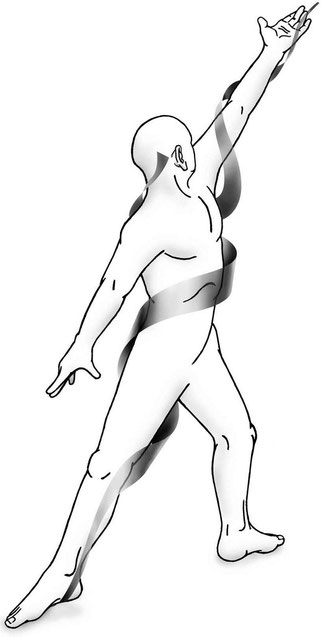DEFINING THE ALEXANDER TECHNIQUE Tim
Soar © 1999
23. Spirals in Muscles and Movement
In fish, the principal muscle masses are located in the sides of their bodies and are aligned longitudinally, to enable the characteristic side to side undulating movement of fishy swimming.
Reptiles tend to have longitudinally aligned back and front muscles in addition to fish-like side muscles; their leg muscles are also aligned along the length of the limb
bones.

We humans on the other hand exhibit a marked spiralic (or more correctly helical) orientation of much of our musculature, both in the neck and torso, and in the limbs. This can be traced from muscle to muscle in “lines of traction”l which flow throughout the body.
If you look at the palm of one hand and then turn your palm away from your face, you will have made an obviously spiral-based movement which a lizard, for example, could not imitate. A slightly more complex example: starting from sitting, facing away from the door of the room, rise from the chair, turn and start to walk towards the door, all in one movement. Less obviously, but perhaps more importantly, the spiral nature of our musculature “colours” even our most rectilinear movements. For example, walking involves a significant outwards rotation of each leg from the hip as the leg swings forward, and a complimentary inward rotation as it swings back. At the same time the cross pattern2 of one leg and the opposite arm swinging forward together sets up an alternating diagonal (helical) stretch in the back which helps maintain the balance, rhythm and impetus necessary to walking any distance. Spirals are, therefore, implicit in our upright posture and movement. Some disciplines, such as Aikido and the Feldenkrais Method make explicit use of obviously spiralic movements in their quest for increased vitality and improved coordination.
Spirals are also implicated in the single most common mis-understanding of the Alexander Technique. Because of the prevailing attitude to “good posture” (it‘s about being “straight”), and the apparent “squareness” of the normal Alexander procedures (tablework, monkey, chairwork etc), it is often thought that the Technique advocates a very rectilinear way of moving. It has even been suggested that the Alexander Technique cannot be applied to activities such as playing the flute because “you’re not allowed to twist”(!) Perhaps even more sadly, some Alexander students,3 suffering under this misapprehension, deliberately try to move in a rectilinear way, and limit the spiral elements of their movements to a degree normally seen only in cases of spinal injury, brain damage or dangerously low physical fitness.
Most people making rotational movements do not “spin expansively” (going up) but rather “twist constrictively” (pulling down). The Alexander Technique seeks to remedy this situation by encouraging people to uncoil from their habitual twists towards a state of neutrality which makes the natural and appropriate use of the spiral musculature more, rather than less, available.
1 An expression coined by the palaeoanthropologist Professor Raymond Dart (1893-1988), a student of the Alexander Technique. He had a particular interest in the evolution of human upright posture.
2 Cross pattern: The neuromuscular connection and sympathetic movement between diagonally opposed limbs (eg right leg and left arm) normally established during the crawling phase of childhood development, enabling fast crawling analogous to trotting in horses.
3 Dubbed Alexandroids because of their robotic movements.